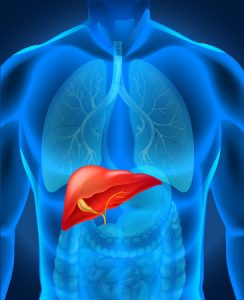Dictionary of Key Terms about Fibrolamellar Hepatocellular Carcinoma
By Dr. Irene Isabel Lim, Dr. Benjamin Farber, Dr. Sanford Simon

Carcinoma
A carcinoma is a cancer that comes from what are called “epithelial cells.” These are the cells that both form the glands and line the surface on the inside and outside of the body. Carcinomas are the most frequent cancer and examples include liver, breast and lung cancers. Examples of other kinds of cancers include sarcomas (cancers from “mesenchymal” cells of the bone, muscle, fat), lymphomas (from blood cells) and blastoma (from premature cells or embryonic cells – a common group of tumors in children).
Chemotherapy,
Neoadjuvant
Neoadjuvant chemotherapy means the patient receives chemotherapy prior to surgical resection of the primary tumor. Neoadjuvant chemotherapy is sometimes offered so an unresectable tumor may become resectable, or to downsize a tumor to allow a different surgery to be performed.
Chemotherapy,
Adjuvant
Adjuvant chemotherapy means the patient receives chemotherapy after surgical resection of the primary tumor.
CT Scan
A CT scan, also known as a CAT Scan, stands for computerized tomography scan (or computerized axial tomography scan). This machine uses a series of x-ray scans through the body, collects the results of all of the scans, and uses a computer to reconstruct a three-dimensional image of the body. [The term tomography refers to recreating a three-dimensional image from the two-dimensional scans]. Any single type of scan (MRI, PET, CT) may not provide all the necessary information for the doctors. As a result, physicians often use a few different types of scans.
Fibrolamellar Hepatocellular Carcinoma (FLC)
Fibrolamellar (FLC) is a malignancy in the liver. While it shares part of the name of “hepatocellular carcinoma,” it is believed to be an unrelated disease, although some web sites still refer to it as a variant of hepatocellular carcinoma. Whereas hepatocellular carcinoma is the result of damage to the liver from viruses such as hepatitis B or C or drinking alcohol, there are, as of today, no known causes for fibrolamellar. Fibrolamellar is primarily seen in patients from their young teens to late twenties. There are no clear blood tests or markers for the disease, thus, it is not known how many cases are missed.
Hepatocellular Carcinoma (HCC)
HCC is the most common form of liver cancer. It is believed to be a consequence of sustained damage to the liver from viruses (such as hepatitis B or C) or from alcohol abuse. While some web sites refer to fibrolamellar as being a variant of hepatocellular carcinoma, there is no evidence that they have a similar cause. Treatments that work for HCC are not known to work for FLC.
Interferon
When cells are infected by viruses, bacteria, or transformed by cancer, the cells activate a response by secreting a group of proteins called interferons. The release of interferons has many effects, ranging from activating immune cells to blocking infection. One particular type of interferon, called interferon alpha, has been reported to have two effects on cancer: It improves the ability of the immune system to fight cancer and it may directly act on the cancer cells to slow their growth.
Kinases
In general, adding or removing various molecules to a protein can make the protein more active, or less active. For example, a protein can be modified by adding something called a phosphate to it. Kinases are the machines that do this adding. In many cancers the kinases are more active than in normal cells. This has led to the development of drugs that block kinases. While these drugs will affect all cells, they are particularly potent for certain cancer cells. Nexavar is an example of a drug that blocks a number of different kinds of kinases.
Malignancy
Malignancy is the tendency of a medical condition, especially tumors, to become progressively worse. Malignancy or “malignant” is sometimes used as a synonym for cancer. Malignant tumors are thought of as being more aggressive than benign tumors (or “non-cancerous” tumors) because of their ability to spread or “metastasize.”
Metastasis
A tumor that spreads from a first location to another (or primary site to secondary) is a metastasis.
Margins
Margins refer to the edges of the tumor. When a tumor is removed during surgery, a pathologist will examine its edges to see how far away the cancer cells are from the edge. Negative, or “clean,” margins mean the edges of the sample appear to be clear of tumor cells. This increases the likelihood that the tumor is contained and has not spread.
MRI Scan
The term stands for magnetic resonance imaging. A set of strong magnetic fields are used to create 3D images. No radiation is used in an MRI. MRI scans are used for a variety of cancers including those found in soft tissues, such as the liver. Often the scan will initially be done twice; for the second scan, a small amount of liquid may be injected via an IV to enhance the image of the liver. Any single type of scan (MRI, PET, CT) may not provide sufficiently specific information for the doctors. Thus, they often request several different kinds of scans. If you are preparing yourself or your child for an MRI scan, know in advance that it will be loud and those with claustrophobia may feel uncomfortable. Relaxation is key. Many facilities let allow patients to listen to music during the scan. This is both soothing and distracting. Find out in advance if you can bring a CD or MP3 music player.
Oncologist
An oncologist is a doctor who specializes in cancer and may advise using such therapies as surgery, chemotherapy and/or radiation.

